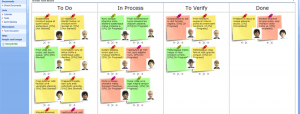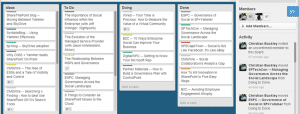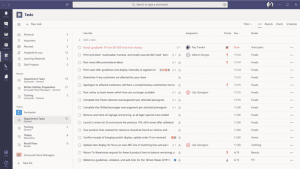Microsoft’s Vision for Task Management
At the start of my technology career in the early 1990’s, I spent a couple years as a technical writer and then a business analyst before moving into a technical project management role, where I spent most of the next decade, eventually building out PM and BA teams for a couple companies, and then serving as a PM-focused consultant, helping to build and launch project management organizations. While in these PM-focused roles, I helped design and launch a number of project, portfolio, and knowledge management technologies…which was how I found my way into the collaboration space a decade later. And then I discovered SharePoint, and have been a part of the Microsoft ecosystem ever since.
One of the areas that I have remained passionate throughout my 15 years in this ecosystem has been task management. In fact, a few weeks after joining Microsoft back in 2006, the company held an employee-only internal product fair out on the old (now gone) soccer fields. As soon as I made it from Building 115 over to the East Campus, I made a beeline straight for the MS Project booth to talk with the team that owned Project Server so I could provide them with some “creative feedback” about the technology, share my experience in deploying it at a customer location, and ask questions about the product roadmap. You could say that I had some pent up frustration on the matter.
The technology has come a long way since then. While MS Project could make an argument for being the industry-leading solution (at least for the desktop), the most common tool actually used for project management schedule building and planning is Excel. Even with Microsoft’s many solutions, and possibly the leading PM tool for the desktop, the fact remains that no single vendor “owns” the project/portfolio management category. Part of the problem is that project management methodologies vary widely, and the tools that support and enable them can be equally complex. The other issue is that what people (management) really wants out of a PM solution is less about task and resource management and more about reporting and decision support. Project management solutions can generate a tremendous amount of data, and management teams want to leverage that data to better streamline operations, mitigate risks, and decrease costs. Unfortunately, all of this complexity makes it difficult for front-line managers and PMs to adequately leverage this same technology for simple day-to-day task visibility and management.
Microsoft has a vision
 For years, Microsoft has not done much to resolve these issues and provide the world with tools that users and project managers can use to manage the day-to-day, but that also roll up to the team, business unit, divisional, and company-wide reporting that management teams desire. However, things finally seem to be changing. Microsoft has announced a number of new integrations between key workloads, including Microsoft Teams, Planner, Outlook, To-Do and more, and shared their vision for tasks in Microsoft 365 revolves around three core principles:
For years, Microsoft has not done much to resolve these issues and provide the world with tools that users and project managers can use to manage the day-to-day, but that also roll up to the team, business unit, divisional, and company-wide reporting that management teams desire. However, things finally seem to be changing. Microsoft has announced a number of new integrations between key workloads, including Microsoft Teams, Planner, Outlook, To-Do and more, and shared their vision for tasks in Microsoft 365 revolves around three core principles:
- Coherence: tasks experiences across Microsoft 365 will have a consistent and familiar experience anywhere they occur, to enable action, navigation, and discovery by users.
- Intelligence: tasks will leverage the intelligent services underpinning Microsoft 365, such as the Microsoft Graph or MyAnalytics, to proactively help users manage and prioritize their workload.
- Integration: wherever a task experience exists in Microsoft apps and services, it will connect to and feed into one of two key task-management endpoints – To Do for individual task management, or Planner for team task management.
This is, of course, exciting news for PMs and project-based organizations who leverage Microsoft products and services. And as Microsoft has demonstrated over the last few years, the rate of change is likely to come very fast — so get ready for it.
Why integration is needed
 This isn’t about reducing tool complexity, or even shelving one or more of these technologies — which I expect to happen, and is a normal part of the innovation process. With the expansion of cloud-based solutions, there seems to be a trend toward kanban list management tools, which better fit the agile project management needs employed by many organizations — but that isn’t the only reason, either. We need integration because our end user experiences demand it. We need PM tools that are fully integrated into our core information worker experiences so that we can create, respond to, and manage tasks wherever we are working — without having to toggle over to a separate website or tool to enter a status or track out time.
This isn’t about reducing tool complexity, or even shelving one or more of these technologies — which I expect to happen, and is a normal part of the innovation process. With the expansion of cloud-based solutions, there seems to be a trend toward kanban list management tools, which better fit the agile project management needs employed by many organizations — but that isn’t the only reason, either. We need integration because our end user experiences demand it. We need PM tools that are fully integrated into our core information worker experiences so that we can create, respond to, and manage tasks wherever we are working — without having to toggle over to a separate website or tool to enter a status or track out time.
One of the reasons why Microsoft Teams has taken off so quickly and with such trajectory is because it merges content and document collaboration with communication, surfaces tacit knowledge, and provides a more organic social experience than was available through other tools and systems. Just as social capabilities inline and in-context to our content improves engagement and collaboration, having organic, fully-integrated task management within these same workloads will improve the quantitative and qualitative measurements of our task and project management.
 Having a conversation with someone on your team about a new project via a Microsoft Teams chat may lead to tasks being defined and created, whether manually by one or both of you, or pulled from the conversation using Cortana’s AI and presented in a visual card in Teams for your approval and assignment. Or someone sends you an email asking for your help in researching something, and once again Cortana identifies several possible tasks, and asks if you would like them to be added to your To-Do list. Or several different project managers on different project teams all circle you like sharks in the water, wanting to assign a handful of tasks to you — but quickly realize through shared resources that your subject-matter expertise is in high demand, and that you availability is scarce. We are very close to making all of this a reality within Microsoft 365.
Having a conversation with someone on your team about a new project via a Microsoft Teams chat may lead to tasks being defined and created, whether manually by one or both of you, or pulled from the conversation using Cortana’s AI and presented in a visual card in Teams for your approval and assignment. Or someone sends you an email asking for your help in researching something, and once again Cortana identifies several possible tasks, and asks if you would like them to be added to your To-Do list. Or several different project managers on different project teams all circle you like sharks in the water, wanting to assign a handful of tasks to you — but quickly realize through shared resources that your subject-matter expertise is in high demand, and that you availability is scarce. We are very close to making all of this a reality within Microsoft 365.
Modern project management is about capturing the information necessary to track tasks, and provide data for managers to make decisions. That’s it, in a nutshell. You may or may not agree with this definition, but at its core, project management is just another aspect of collaboration and knowledge management, albeit at a much more tactical level. I’m excited to see Microsoft *finally* treating task management as a full citizen of the collaboration stack, and planning for a consistent, integrated task management solution across all of the Microsoft 365 workloads.
The task management blog series
Over the next few weeks, I plan to write a series of blog posts that explore each of the Microsoft 365 workloads where tasks may live. I will share what is available today following Microsoft’s task management vision, what has been shared publicly about the roadmap, and provide my thoughts and feedback (and some speculation) on where I believe microsoft needs to go with each. I also hope to interview some of the members of the respective product teams as part of my #Loop365 series, so be sure to watch for that on the CollabTalk podcast and YouTube pages, as well.
Additionally, in case you missed them, here are several recent articles that highlight various aspects of Microsoft task management strategy:






